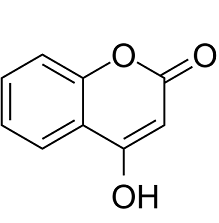4-Hydroxycoumarin, a coumarin analog, is a versatile heterocyclic scaffold that has been frequently applied in the synthesis of various organic compounds. 4-Hydroxycoumarin possesses both electrophilic and nucleophilic properties. 4-Hydroxycoumarin analogues are employed as the anticoagulant, antibacterial, antifungal, antiviral, antitumor, antiprotozoal, insecticidal, antimycobacterial, antimutagenic, antioxidant, anti-inflammatory agents, HIV protease inhibitors and tyrosine kinase inhibitors.
Physicochemical Properties
| Molecular Formula | C9H6O3 |
| Molecular Weight | 162.1421 |
| Exact Mass | 162.031 |
| Elemental Analysis | C, 66.67; H, 3.73; O, 29.60 |
| CAS # | 1076-38-6 |
| PubChem CID | 54682930 |
| Appearance | White to off-white solid powder |
| Density | 1.4±0.1 g/cm3 |
| Boiling Point | 352.4±42.0 °C at 760 mmHg |
| Melting Point | 211-213 °C(lit.) |
| Flash Point | 165.4±20.7 °C |
| Vapour Pressure | 0.0±0.8 mmHg at 25°C |
| Index of Refraction | 1.660 |
| LogP | 1.6 |
| Hydrogen Bond Donor Count | 1 |
| Hydrogen Bond Acceptor Count | 3 |
| Rotatable Bond Count | 0 |
| Heavy Atom Count | 12 |
| Complexity | 232 |
| Defined Atom Stereocenter Count | 0 |
| SMILES | O1C(C([H])=C(C2=C([H])C([H])=C([H])C([H])=C12)O[H])=O |
| InChi Key | VXIXUWQIVKSKSA-UHFFFAOYSA-N |
| InChi Code | InChI=1S/C9H6O3/c10-7-5-9(11)12-8-4-2-1-3-6(7)8/h1-5,10H |
| Chemical Name | 4-hydroxy-2H-chromen-2-one |
| Synonyms | Benzotetronic Acid; 4-Hydroxycoumarin; 4 Hydroxycoumarin; 4-Coumarinol; 4 Coumarinol; NSC 11889; NSC11889; NSC-11889; |
| HS Tariff Code | 2934.99.9001 |
| Storage |
Powder-20°C 3 years 4°C 2 years In solvent -80°C 6 months -20°C 1 month |
| Shipping Condition | Room temperature (This product is stable at ambient temperature for a few days during ordinary shipping and time spent in Customs) |
Biological Activity
| References |
[1]. The molecular diversity scope of 4-hydroxycoumarin in the synthesis of heterocyclic compounds via multicomponent reactions. Mol Divers. 2019 Jan 29. doi: 10.1007/s11030-019-09918-7. [2]. 4-Hydroxycoumarin disorganizes the actin cytoskeleton in B16-F10 melanoma cells but not in B82 fibroblasts, decreasing their adhesion to extracellular matrix proteins and motility. Cancer Lett. 2003 Aug 20;198(2):179-86. [3]. Antimetastatic, antineoplastic, and toxic effects of 4-hydroxycoumarin in a preclinical mouse melanoma model. Cancer Chemother Pharmacol. 2010 Apr;65(5):931-40. [4]. Intestinal anti-inflammatory activity of coumarin and 4-hydroxycoumarin in the trinitrobenzenesulphonic acid model of rat colitis. Biol Pharm Bull. 2008 Jul;31(7):1343-50. |
| Additional Infomation |
4-hydroxycoumarin is a hydroxycoumarin that is coumarin in which the hydrogen at position 4 is replaced by a hydroxy group. It is a conjugate acid of a 4-hydroxycoumarin(1-). 4-Hydroxycoumarin has been reported in Ruta graveolens, Vitis vinifera, and Apis cerana with data available. |
Solubility Data
| Solubility (In Vitro) | DMSO : ~250 mg/mL (~1541.88 mM) |
| Solubility (In Vivo) |
Solubility in Formulation 1: ≥ 2.08 mg/mL (12.83 mM) (saturation unknown) in 10% DMSO + 40% PEG300 + 5% Tween80 + 45% Saline (add these co-solvents sequentially from left to right, and one by one), clear solution. For example, if 1 mL of working solution is to be prepared, you can add 100 μL of 20.8 mg/mL clear DMSO stock solution to 400 μL PEG300 and mix evenly; then add 50 μL Tween-80 to the above solution and mix evenly; then add 450 μL normal saline to adjust the volume to 1 mL. Preparation of saline: Dissolve 0.9 g of sodium chloride in 100 mL ddH₂ O to obtain a clear solution. Solubility in Formulation 2: ≥ 2.08 mg/mL (12.83 mM) (saturation unknown) in 10% DMSO + 90% (20% SBE-β-CD in Saline) (add these co-solvents sequentially from left to right, and one by one), clear solution. For example, if 1 mL of working solution is to be prepared, you can add 100 μL of 20.8 mg/mL clear DMSO stock solution to 900 μL of 20% SBE-β-CD physiological saline solution and mix evenly. Preparation of 20% SBE-β-CD in Saline (4°C,1 week): Dissolve 2 g SBE-β-CD in 10 mL saline to obtain a clear solution. Solubility in Formulation 3: ≥ 2.08 mg/mL (12.83 mM) (saturation unknown) in 10% DMSO + 90% Corn Oil (add these co-solvents sequentially from left to right, and one by one), clear solution. For example, if 1 mL of working solution is to be prepared, you can add 100 μL of 20.8 mg/mL clear DMSO stock solution to 900 μL of corn oil and mix evenly. (Please use freshly prepared in vivo formulations for optimal results.) |
| Preparing Stock Solutions | 1 mg | 5 mg | 10 mg | |
| 1 mM | 6.1675 mL | 30.8375 mL | 61.6751 mL | |
| 5 mM | 1.2335 mL | 6.1675 mL | 12.3350 mL | |
| 10 mM | 0.6168 mL | 3.0838 mL | 6.1675 mL |
